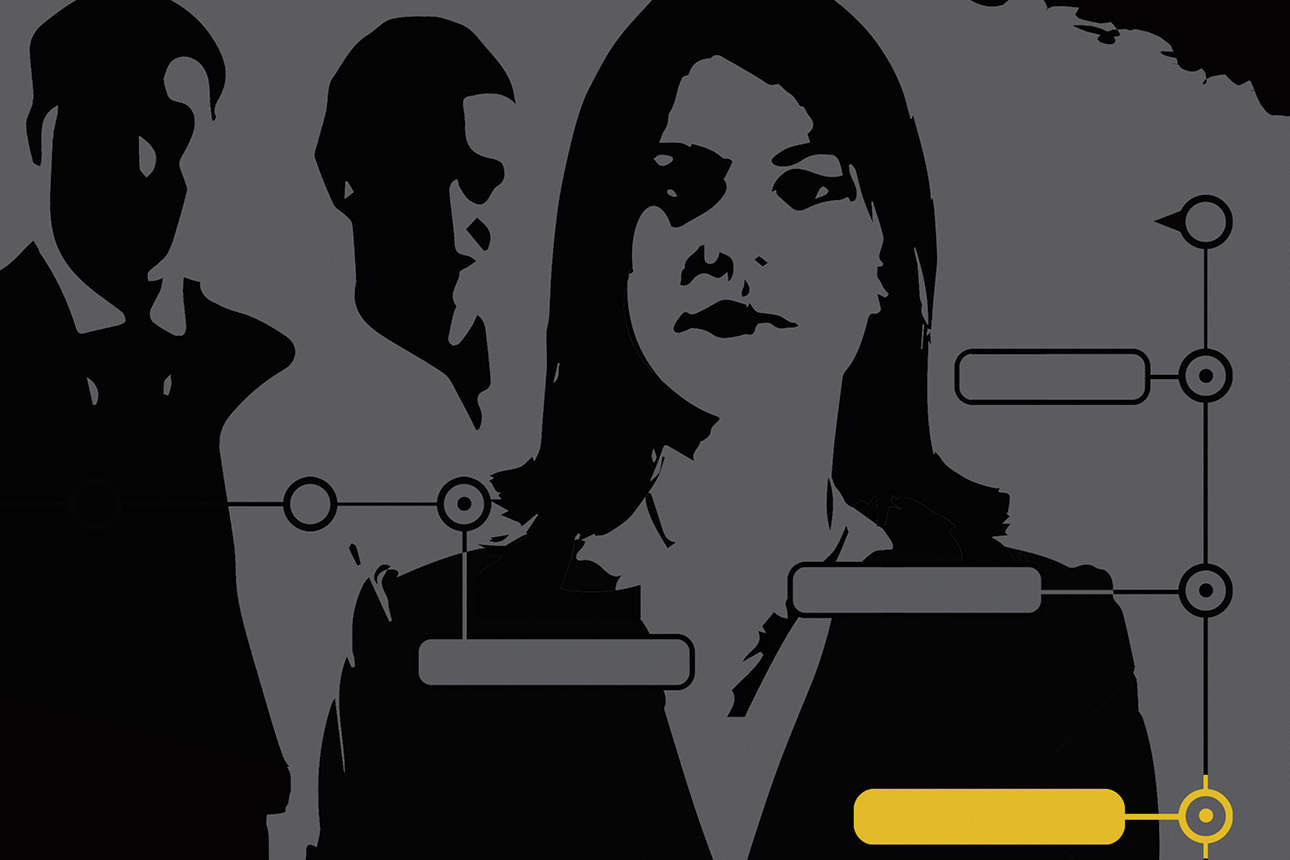MIT Sloan Management Review, December 22, 2020
by Theodore Kinni
Over the past four years, many of the United States’ geopolitical alliances have been remade with bewildering speed. It’s no surprise that many of those changes created an uproar — some of these relationships dated back a century or more and seemed sacrosanct, until they weren’t. It also prompted Stephen Walt, the Robert and Renée Belfer Professor of International Relations at Harvard University, to cut through the noise with an article in Foreign Policy titled “How to Tell if You’re in a Good Alliance,” which is instructive for business leaders as well as diplomats.
Walt is a pragmatist, so the first thing he points out is the unspoken assumption behind the uproar: that each of a nation’s existing political alliances is actually worth maintaining. “Surely this is not the case, for all allies are not created equal, and the value of any commitment is likely to wax and wane over time,” he writes. “Wise countries choose their allies carefully and do not treat any of them as sacred and inviolable.”
This is as true in business as it is in international relations. Corporate alliances are a means to an end, and they involve costs and obligations. Accordingly, corporate leaders, like the heads of nations, should never take the value of their partnerships for granted. Toward that end, you can conduct a fast review of the value of your company’s alliances by asking the following four questions, derived from the short list of attributes of a good ally that Walt offers in his article.
Does your partner make a meaningful contribution to the alliance? This is a key question when reviewing a partnership. It’s also one that torpedoed the 2009 alliance between Suzuki Motor Corp. and Volkswagen. Volkswagen wanted to gain greater access to the fast-growing Indian market through Suzuki, and Suzuki wanted access to Volkswagen’s hybrid and diesel technologies. The problem, claimed Suzuki chairman Osamu Suzuki less than two years after the companies bought stakes in each other, was that the technology Suzuki sought wasn’t forthcoming. Suzuki didn’t need the technology that VW was willing to provide, and VW wouldn’t provide access to the technology that it did need. If your partner hasn’t made the contributions it promised, you don’t have a good ally. Read the rest here.
Tuesday, December 22, 2020
Four Questions for Appraising Your Alliances
Posted by
Theodore Kinni
at
8:38 AM
0
comments
![]()
Labels: corporate success, decision making, partnering, strategy
Thursday, December 17, 2020
Is the gig up?
strategy+business, December 17, 2020
by Theodore Kinni
Photograph by Brothers91
A decade ago, advocates touted the sharing economy as an alternative to corporate capitalism. Digital technology was opening vast, new peer-to-peer marketplaces: TaskRabbit and Airbnb were founded in 2008, Uber in 2009, RelayRides (now Turo) in 2010, Postmates in 2011, Lyft in 2012. These platforms promised that people would be able to make a good living while working when and how they wanted — selling their time and skills, and renting out their cars, spare bedrooms, and that dusty camping gear in the attic.
“You will know by now that things haven’t turned out exactly as expected,” Juliet Schor wryly notes in her new book, After the Gig. Schor, a sociology professor at Boston College, and her team at the Connected Consumption project, funded by the MacArthur Foundation, studied gig workers and platforms of the sharing economy from 2011 to 2017. The result is a more nuanced view than has been offered by previous books on this topic, which typically focus on either how companies can build their own platforms or how platform companies prosper by evading regulation and exploiting workers.
This finding partly contradicts the headlines of worker abuse that have generated a lot of political Sturm und Drang lately. At the same time, it is clear that the gig economy can’t really substitute for a full-time job. As Schor concludes: “With some exceptions, our data suggest that being dependent on a platform is not a viable way to make a living.” Read the rest here.
Posted by
Theodore Kinni
at
1:53 PM
0
comments
![]()
Labels: bizbook review, books, business history, digitization, employee experience, platforms, strategy+business, technology, work
Tuesday, November 24, 2020
The Transformational Power of Recommendation
Learned a lot lending an editorial hand here:
MIT Sloan Management Review, November 24, 2020
by Michael Schrage
Image courtesy of Paul Giovanopoulos/theispot.com
Wikipedia defines recommendation engines (and platforms and systems) as “a subclass of information filtering system that seeks to predict the ‘rating’ or ‘preference’ a user would give to an item.” But as a tool, technology, and digital platform, recommendation engines are far more intriguing and important than this definition suggests.
In data-driven markets, the most effective competitors reliably offer the most effective advice. When predictive analytics are repackaged and repurposed as recommendations, they transform how people perceive, experience, and exercise choice. The most powerful — and empowering — engines of commerce are recommendation engines.
Recommendation engines have been essential to the success of digital platforms Alibaba, Amazon, Netflix, and Spotify, according to their founders and CEOs. For companies such as these, recommendation engines aren’t merely marketing or sales tools but drivers of insight, innovation, and engagement. Superior recommendations measurably build superior loyalty and growth; they amplify customer lifetime value. Computing compelling recommendations profitably reshapes human behavior.
The influence and purpose of recommendation engines are not limited to customers or consumption. Large employers, most notably Google, have adopted and adapted recommendation engines as internal productivity platforms to nudge workers to their best decision options. Indeed, in late 2016, Laszlo Bock, the senior vice president of people operations at Google, left the company to launch Humu, a recommendation-engine startup for advising workforce behavior change.
While data remains the essential advisory ingredient, the global recommendations revolution reflects profound and ongoing algorithmic innovation, enabling machine learning and AI to power improvements in deep learning and generative adversarial networks. Successful recommendation engines learn how to learn. The more people use them, the smarter they become; the smarter they become, the more people use them. Done right, recommendation engines enable virtuous cycles of value creation.
The networked nudges and prompts of recommendation engines increasingly influence people’s choices in clothing, entertainment, food, and medicine; they also influence the texts we send, which friends we contact, the customers and prospects we prioritize, the experts we seek, the job candidates we hire, the investments we choose, the memos we edit, and the schedules we follow.
But prompts and nudges shouldn’t obscure the subtle but vital design principle that makes the recommendation-engine value cycle more virtuous: Recommendation is about ensuring better options and choices, not obedience or compliance. Recommendation engines don’t seek to impose optimal, best, or right answers on their users. To the contrary, their point and purpose are greater empowerment and agency. Influence, not control, is the algorithmic aspiration. In this, successful recommendation-engine design depends more on how recommenders seek to influence than on how much they know.
Recommendation engines transform human choice. Much as the steam engine energetically launched an industrial revolution, recommendation engines redefine insight and influence in an algorithmic age. Wherever choice matters, recommenders flourish, and this profound digital transformation of choice will only become more pervasive as recommenders become smarter. Better recommenders invariably mean better choices. Read the rest here.
Posted by
Theodore Kinni
at
11:39 AM
0
comments
![]()
Labels: AI, analytics, books, corporate success, customer experience, data science, employee experience, recommendation engines
Thursday, November 19, 2020
The New Elements of Digital Transformation
Learned a lot lending an editorial hand here:
MIT Sloan Management Review, November 19, 2020
by Didier Bonnet and George Westerman
Image courtesy of Michael Glenwood Gibbs/theispot.com
Since 2014, when our article “The Nine Elements of Digital Transformation” appeared in these pages, executive awareness of the powerful and ever-evolving ways in which digital technology can create competitive advantage has become pervasive. But acting on that awareness remains a challenging prospect.
It requires that companies become what we call digital masters. Digital masters cultivate two capabilities: digital capability, which enables them to use innovative technologies to improve elements of the business, and leadership capability, which enables them to envision and drive organizational change in systematic and profitable ways. Together, these two capabilities allow a company to transform digital technology into business advantage.
Digital mastery is more important than ever because the risks of falling behind are increasing. In 10 years of research, we have seen digital transformation grow increasingly complex, with a new wave of technological and competitive possibilities arriving before many companies mastered the first. When we began our research, most large traditional enterprises were using digital technologies to incrementally improve parts of their businesses. Since then, this first phase of activity has given way to a new one. Advances in a host of technologies, such as the internet of things, artificial intelligence, virtual and augmented reality, and 5G, have opened new avenues for value creation. More important, leaders now recognize the need for — and the possibility of — truly transforming the fundamentals of how they do business. They understand that they have to move from disconnected technology experiments to a more systematic approach to strategy and execution.
Some companies have successfully graduated from the first phase of digital transformation and are diving into the second. But many are still floundering: In 2018, when we surveyed 1,300 executives in more than 750 global organizations, only 38% of them told us that their companies had the digital capability needed to become digital masters, and only 35% said they had the leadership capability to do so. This has become more worrisome than ever: As COVID-19 accelerates the shift to digital activity, digital masters are widening the gap between their capabilities and those of their competitors.
These conditions prompted us to reexamine the elements of digital transformation that we proposed in 2014. While strong leadership capability is even more essential than ever, its core elements — vision, engagement, and governance — are not fundamentally changed, though they are informed by recent innovations. The elements of digital capability, on the other hand, have been more profoundly altered by the rapid technological advances of recent years. Read the rest here.
Posted by
Theodore Kinni
at
12:12 PM
0
comments
![]()
Labels: change management, corporate success, digitization, employee engagement, management, platforms, technology, transformation
Wednesday, November 18, 2020
When Employees Speak Up, Companies Win
Learned a lot lending an editorial hand here:
MIT Sloan Management Review, November 17, 2020
by Ethan Burris, Elizabeth McCune, and Dawn Klinghoffer
Business headlines suggest that employees are speaking up more than ever. Activist employees are calling out their companies over where and with whom they do business, burned-out employees are asking for more and more unique work-life accommodations, and concerned employees are raising questions about hiring practices and promotion decisions in light of institutional biases. Often, these instances of speaking up — called employee voice behaviors — result in an embarrassingly public airing of organizational issues.
Yet our research reveals that the headlines are not an accurate reflection of the current state of employee voice. We asked 6,000 employees of a Microsoft business unit to tell us how often they spoke up to their managers. In addition, we asked how many of 15 topics they spoke up about, such as their immediate job assignments, the culture of their teams, how employees are treated across the organization, the strategy of the company, and the work-life balance alternatives available to them. We found that relatively few employees consistently share their thoughts and opinions about a multitude of work issues with their managers: Just 13.6% of the surveyed employees said that they speak up on more than 10 of the topics. Slightly more are silent: In fact, 17.5% said they do not speak up at all. The largest group of employees — 47.1% — said they speak up on five or fewer topics, typically on issues related to their jobs.
If we assume that these findings reflect similar tendencies in other organizations, leaders should be concerned, because employee voice is not a voice of complaint or protest per se. It encompasses the willingness of employees to speak up about opportunities for improvement. These efforts are not a prescribed part of employees’ jobs; they are a voluntary communication of constructive ideas to leaders that enable learning and effective change in work groups of all sizes, from teams to entire organizations. Yet these efforts to tell the truth can involve confronting leaders, who can feel challenged or even threatened, especially when the proposed changes involve things that leaders have helped create or for which they are responsible.
More and more, companies are seeking to expand efforts to listen to their employees by inviting them to share their opinions and ideas in areas that are outside of their day-to-day tasks. For instance, in 2014, in the aftermath of a recall of 6 million vehicles for an ignition flaw linked to at least 13 deaths, General Motors launched its Speak Up for Safety program, which asked employees across the company to speak up about anything that might impact customer safety. The growing use of innovation platforms and ecosystems is another example. In addition, during the global COVID-19 pandemic, we’ve seen companies frequently survey employees on topics such as physical and mental health and their working conditions.
The effectiveness of all these efforts depends on employees’ willingness to use their voices. In this study, we sought to examine the benefits of a more expansive employee voice, the factors that determine voice behaviors, and the ways in which companies can encourage those behaviors. Read the rest here.
Posted by
Theodore Kinni
at
3:26 PM
0
comments
![]()
Labels: analytics, corporate success, employee engagement, human resources, inclusion, management, work
Wednesday, November 11, 2020
What people like you like
strategy+business, November 11, 2020
by Theodore Kinni
Photograph by Paper Boat Creative
I don’t set much store in the endless stream of recommendations offered by Amazon, Netflix, Spotify, and most other online businesses. Occasionally, a book, flick, or song pops up that delights me, but most of the suggestions I get either miss the mark or appear suspiciously advantageous to recommendation engine operators and their advertisers.
Michael Schrage, visiting fellow at the MIT Sloan School of Management’s Initiative on the Digital Economy and s+b contributor, awakens us to the potential of delightful discovery in his latest book, Recommendation Engines. “Recommendation inspires innovation: that serendipitous suggestion—that surprise—not only changes how you see the world, it transforms how you see—and understand—yourself. Successful recommenders promote discovery of the world and one’s self,” Schrage writes in its introduction. “Recommenders aren’t just about what we might want to buy; they’re about who we might want to become.”
If this smacks of techno-utopianism, well, there is a strong strain of that ideology running through Recommendation Engines. For the most part, however, Schrage grounds this rosy view in the powerful effects that recommenders are already producing and balances it with acknowledgment of these systems’ potential for abuse. He also provides a short history of recommendations and a suitably technical description of how recommendation engines work and are built.
To date, the powerful effects of recommenders have manifested themselves mostly in commerce. Schrage cites a variety of facts in this regard: a survey that found recommendations account for approximately 30 percent of global e-commerce revenues; another that found online shoppers are 4.5 times more likely to buy after clicking on a recommendation; and research that “strongly suggests” recommendations drive roughly a third of Amazon’s sales. Read the rest here.
Posted by
Theodore Kinni
at
11:36 AM
0
comments
![]()
Labels: AI, bizbook review, books, corporate success, data science, decision making, digitization, platforms, recommendation engines, strategy+business, technology
The Rising Risk of Platform Regulation
Learned a lot lending an editorial hand on this article:
by D. Daniel Sokol and Marshall Van Alstyne

On Oct. 6, 2020, the U.S. House Judiciary Committee’s antitrust subcommittee released a 450-page report following a 16-month inquiry into the digital economy. It recommended fundamental changes to antitrust laws generally and targeted the Amazon, Apple, Facebook, and Google technology platforms specifically. Several weeks later, the U.S. Department of Justice filed suit against Google, accusing it of using “anticompetitive tactics to maintain and extend its monopolies in the markets for general search services, search advertising and general search text advertising.” Similar regulatory initiatives aimed at platforms are underway around the world, including in the European Union, United Kingdom, Japan, Korea, and India.
The blizzard of regulatory action swirling around platforms is producing new rules and laws, expanded powers for existing regulatory authorities, and the establishment of new regulatory authorities. These outcomes will not only affect Big Tech but also many other companies, in industries such as construction, health care, finance, energy, and industrial manufacturing, that have adopted or are considering adopting platform business models.
Few platform operators and owners have fully considered how the growing regulatory risk — which includes breakups, line-of-business restrictions, acquisition limits, and interoperability and data portability mandates — could derail their businesses. As a result, they could be caught off guard, just like many companies were caught off guard when the Sarbanes-Oxley Act of 2002 mandated board restructurings and expanded executive financial accountability in the aftermath of accounting scandals. Read the rest here.
Posted by
Theodore Kinni
at
11:28 AM
0
comments
![]()
Labels: corporate success, digitization, government, management, platforms, regulation
Monday, November 9, 2020
Best Business Books 2020: Management
strategy+business, November 9, 2020
by Theodore Kinni
Illustration by Martin O’Neill; icon by Harry Campbell
This year, COVID-19 upended management-as-usual. Sure, managing is still a matter of getting things done in organizations — divvying up objectives into tasks, ensuring employees have the resources and skills to complete the tasks, overseeing their progress, and helping them when they get bogged down. But where and how people work has changed — radically and overnight in many companies and, in some, maybe permanently.
None of this year’s best business books on management were written for managers per se. But each focuses on capabilities that can help managers identify and cope with pandemic-related challenges.These developments have given rise to new needs and stresses that affect the people you are responsible for managing — needs such as going to work (or going back to work) safely, and stresses such as working while surrounded by kids instead of colleagues — and thus, they’ve also affected your performance as a manager.
In the year’s best business book on management, Tiny Habits, Stanford University professor B.J. Fogg shows how to change your behavior and help others change theirs, too — an essential skill at a time when we are all being called upon to develop new habits. In Acting with Power, Deborah Gruenfeld, also at Stanford, explains how an unconventional view of power can enable you to support people in ways that far exceed the limits of your positional authority. And in You’re Not Listening, journalist Kate Murphy offers an uncommonly insightful exploration of how to actually meet the dictates of an exhortation we’ve all heard before: “Listen!” Read the rest here.
Posted by
Theodore Kinni
at
10:20 AM
0
comments
![]()
Labels: bizbook review, books, change management, leadership, management, org culture, personal success, strategy+business, work
Thursday, November 5, 2020
To Cut Costs, Know Your Customer
Sloan Management Review, November 4, 2020
by Vikas Mittal, Shrihari Sridhar, and Roger Best

Image courtesy of Robert Neubecker/theispot.com
The economic disruptions caused by the ongoing pandemic are forcing myriad decisions on CEOs of B2B companies. Often, the most pressing decisions are whether and how to cut costs.
As in business downturns past, some CEOs are implementing across-the-board salary cuts and widespread furloughs, while others are taking a more piecemeal approach — renegotiating vendor contracts; trimming underperforming products, regions, and divisions; and shifting to lower-cost sales channels. Our research shows that both of these approaches can be misguided.
A more effective cost-cutting strategy should begin — and end — with customer focus.
Customer focus tends to be overlooked during cost cutting because it is usually seen as a revenue enhancement strategy. This is a mistake: B2B companies that ignore what customers value when they are cutting costs leave a lot of money on the table.
In our benchmark assessment of 626 publicly traded B2B companies and 4,105 of their customers, we found that companies with high levels of cost cutting and low levels of customer value — as measured by customer satisfaction — had the worst gross margins, while companies with high levels of both cost cutting and customer value had the highest margins. In other words, cost cutting that is devoid of customer value sank margins.
B2B companies can pursue cost reduction with a customer focus in three ways: by reducing value-added waste to deliver more compelling customer value, by improving the effectiveness of customer acquisition and retention, and by narrowing focus to those strategic initiatives best aligned with customer value. Read the rest here.
Posted by
Theodore Kinni
at
11:22 AM
0
comments
![]()
Labels: change management, corporate success, cost-cutting, customer experience, decision making, management, service
Tuesday, November 3, 2020
The Six Dysfunctions of Collaborative Work
Learned a lot lending an editorial hand here:
Connected Commons, June 2020
by Rob Cross and Inga Carboni
Beth was excited when the CEO asked her to take over a high-profile commercialization project that had been struggling. The leader in charge of the effort—one expected to double the technology firm’s revenues in the coming decade—had recently accepted another job. Beth accepted the job on the spot.
In her first week, Beth dug in. She found the project fully funded and staffed by 64 carefully selected people from departments across the company, including engineering, marketing, finance, and quality assurance. The threeday, offsite visioning session held to launch the project had been attended by the entire team and was, by all accounts, a resounding success. Three concurrent work-streams—focusing on research, product development, and marketing and sales—were identified and a well-respected leader was appointed for each one.
Yet, ten months later, the project was badly behind schedule and bogged down. Everyone with whom Beth spoke was frustrated with the slow pace of progress. They were all pointing fingers, but in different directions. The CEO believed the problem was a failure of leadership. The departing project leader blamed team members for not devoting enough time to the project. One team member said the problem was poor meeting management; another said key decisions weren’t being made in a timely manner.
What should Beth do? Appoint new workstream leaders? Relaunch the project? Restructure the group or the work? Add more people to the project team? Schedule more meetings or provide an online work platform? ...read the rest here
Posted by
Theodore Kinni
at
10:50 AM
0
comments
![]()
Labels: analytics, corporate life, corporate success, employee experience, management, org culture, personal success, work
Friday, October 16, 2020
Uncertainty on the menu
strategy+business, October 16, 2020
by Theodore Kinni
Photograph by Yagi Studio
If you’re a foodie, the research that Vaughn Tan undertook to write The Uncertainty Mindset will strike you as a dream gig. The assistant professor of strategy and entrepreneurship at University College London’s School of Management spent much of the past decade studying — and embedded within — the culinary R&D teams associated with a handful of the world’s top purveyors of high-end cuisine, including José Andrés’s ThinkFoodGroup, Nathan Myhrvold’s Modernist Cuisine, Heston Blumenthal’s The Fat Duck, René Redzepi’s Noma, and “Amaja” (a pseudonym Tan uses for a restaurant that sounds a lot like Poul Andrias Ziska’s Koks). Aside from the good eats, Tan came away from his research with unconventional ideas for structuring and stimulating innovation teams.
The innovation challenge facing these rarefied culinary organizations is daunting; the customer expectations of an Apple or a Tesla pale by comparison. Imagine trying to satisfy a discerning gourmand who has waited a year for a reservation and then traveled from Singapore to the Faroe Islands solely for an 18-course meal. It is expected to be one of the best meals in the world. Each course features unusual ingredients prepared in unique ways that not only engage the senses but also impart the identity of the chef and the restaurant, so much so that it couldn’t have come from any other kitchen. Tan calls this elusive quality familiar novelty. “Novelty combined with distinctive familiarity makes for loyal customers — and is nearly impossible to copy,” he writes.
Outside London, at The Fat Duck Experimental Kitchen (FDEK), Tan observes pastry chef Isabel Rodriguez as she creates a dessert that will anchor an entirely new menu. “The team had decided that it would have to convey the feeling, as Rodriguez said, of being ‘dreamy, comforting, surreal. Like how you feel when you are about to fall asleep when you’re small. You’ve been bathed, and you’re feeling clean and tired, and everything smells like baby powder,’” writes Tan. Before the work is done, the dish, which the team calls Counting Sheep, will evolve into two dishes served in quick succession. Among its many fine details is the design and fabrication of a spoon with a fuzzy handle that will be dusted lightly with, yes, baby powder.
At Amaja, the R&D team spends three months figuring out how to cook 200-year-old mahogany clams — an ingredient never before used in high cuisine. In ThinkFoodGroup’s first Las Vegas venture, the company takes on the high-pressure work of launching three restaurants — serving tapas, Chinese–Mexican food, and a tasting menu — on the opening night of a newly constructed gaming resort.
In observing how culinary R&D team members work individually and together on such projects, Tan uncovers six “innovation insights” that serve as the core findings of his book. Two of the insights are particularly intriguing. Read the rest here.
Posted by
Theodore Kinni
at
4:20 PM
0
comments
![]()
Labels: bizbook review, books, creativity, innovation, org culture, strategy+business
Thursday, October 15, 2020
What Elite Donors Want
Insights by Stanford Business, October 14, 2020
by Theodore Kinni
REUTERS/Joshua Roberts
In November 2012, newly elected Democratic members of the United States Congress got about a week to savor their victories. Then, the Democratic Congressional Campaign Committee advised them to start hitting the phones for 3-4 hours per day. Who were they supposed to be calling? Mainly, elite donors — the fewer than 1% of Americans who give candidates more than $200 in any given election cycle.
It isn’t news that politicians court elite donors or that elite donors have greater political access and influence than the typical voter. But, as Stanford Graduate School of Business political economist Neil Malhotra points out in an article recently published in Public Opinion Quarterly, “we know remarkably little about what they actually want from government.”
This is a particularly relevant issue during the current, seemingly endless, election cycle, in which the battle for control of the executive and legislative branches of the federal government is unusually contentious and fraught with implications for the future of the nation.
Malhotra and his coauthor David Broockman, a former Stanford GSB professor who recently moved to the University of California, Berkeley, based their findings on a survey they conducted of 1,152 elite donors, who collectively contributed more than $17.2 million to election campaigns since 2008. That survey was performed for an earlier study aimed at understanding the political anatomy of tech entrepreneurs in Silicon Valley, whom they labeled “liberaltarians.” Read the rest here.
Posted by
Theodore Kinni
at
2:05 PM
0
comments
![]()
Labels: government, Insights by Stanford Business, politics, regulation
Tuesday, September 8, 2020
Don’t kill bureaucracy, use it
strategy+business, September 8, 2020
by Theodore Kinni
Photograph by Darren Rowley / EyeEm
Earlier this year, an intriguing tweet from Tom Peters popped up on my phone. “Virtually all the popular improvement ideas — Continuous Improvement, 6-Sigma, MBO [management by objectives], Agile, Brainstorming, Strategic Planning, PPBS [planning, programming, budgeting systems], ZBB [zero-based budgeting] — develop hardening of the arteries, lose their youthful glow, and become one more burdensome, life-sucking bureaucratic practice,” he wrote.
This may sound glib to you. But like many of Peters’s observations, it’s got a strong foundation in reality. If you’ve been around for a while, you know that all sorts of business programs ossify after a few years. It happened with total quality management (TQM) and business process reengineering back in the 1990s. It’s happening with D&I (diversity and inclusion) and holacracy now.
One of Peters’s followers blamed leaders for this phenomenon. But Peters didn’t agree. “My experience is different,” he replied. “All ‘systems’ inevitably calcify, regardless of the leaders. [The] solution is to automatically throw out any such system after, say, 5 years.”
Many companies do exactly that. They deal with the organizational sclerosis that sets in as management programs age by abandoning them for whatever has come along in the meantime. “Forget TQM, let’s do Six Sigma; forget Six Sigma, let’s do Lean.” Often, these moves follow a change in leadership. A new CEO points everyone in a new direction and cuts the old program’s funding. That seems wasteful, at best. Presumably, there were benefits to be had from the program (and almost certainly a substantial amount of money and effort has been expended to establish and maintain it). And then there were none.
But why do improvement programs ossify? Once upon a time, I studied the reasons TQM implementations fail. They included skimpy budgets, ineffectual leaders, spotty managerial support, ill-defined strategies and objectives, poor program and performance measurement, and a lack of training. In other words, a dearth of all the things that bureaucracies are designed to provide. Looking back, I realize that for my analysis of this phenomenon, I could have written, “If you want to embed TQM in your company, you need to build a TQM bureaucracy.”
But that only holds true for implementation. The problem is that once an improvement idea or system becomes established in a large organization, the bureaucracy that successfully established it usually becomes the agent of its ossification. The “center of excellence” gets bloated and dictatorial; new layers of administrative management slow decision making; the flow of work gets jammed up with new tasks and procedures; metrics yield reports that demand managerial attention and sap employee energy... Read the rest here.
Posted by
Theodore Kinni
at
9:08 AM
1 comments
![]()
Labels: change management, corporate life, corporate success, management, org culture, strategy+business, transformation
Thursday, September 3, 2020
Competing on Customer Outcomes
Learned a lot lending an editorial hand here:
MIT Sloan Management Review, September 2, 2020
by Marco Bertini and Oded Koenigsberg 
Image courtesy of Richard Borge/theispot.com
In his 1969 book The Marketing Mode, Harvard Business School professor Theodore Levitt immortalized a gentleman named Leo McGivena, who reportedly said: “Last year 1 million quarter-inch drill bits were sold — not because people wanted quarter-inch drill bits but because they wanted quarter-inch holes.” A half-century later, this insight is as compelling as it ever was — customers still want to buy meaningful outcomes (a particular sensation, a tangible benefit, or some combination of the two), not products and services. What’s changing is companies’ ability to become more accountable for those outcomes by helping customers navigate three critical checkpoints: accessing the solution, consuming (that is, experiencing or using) it, and getting it to perform as expected or above expectation.
Even so, most companies do not stake their success on these checkpoints. Instead, they sell quarter-inch drills and promise customers that the quarter-inch holes they desire will follow. Indeed, a revenue model focused on transferring the ownership of a product or service to the buyer may appear prudent because revenue accrues up front, and any risk associated with access, consumption, and performance is passed on to customers. But in reality it places an unnecessary burden on customers and ultimately shrinks the opportunity in the market. This contraction occurs when, for instance, customers are priced out or forgo a purchase because it is inconvenient, when they perceive ownership as too risky and decide not to buy, and when they resolve to pay less to account for the possibility that they will not make sufficient use of their purchase or that it will not perform as advertised.
Technological advances are enabling companies to rewrite the rules of commerce. Mobile communication, cloud computing, the internet of things, advanced analytics, and microtransactions offer sharper, more timely information that can illuminate when and how customers access and consume their products and services, and whether and how well those products and services perform. We call this information impact data — it enables companies to track and understand what happens to their solutions beyond the moment of purchase.
The way we see it, impact data — and the technologies that deliver and analyze it — is transforming corporate accountability for customer outcomes from a fashionable marketing slogan into a strategic imperative. Some organizations dismiss this imperative, hoping that it is another passing trend. Others (often intentionally) make their prices more ambiguous and thus less comparable across competitors, which impedes sound purchasing decisions on the customer side. These will not be winning plays in the long run. Instead, companies should start to embrace accountability for outcomes and change their revenue models accordingly before they are forced to do so by more enlightened competitors and disruptive startups.
In this article, we’ll describe three types of revenue models that can help companies win customers and drive growth in today’s increasingly transparent markets. The framework draws on insights from our respective academic areas of behavioral economics and operations, our research, and our ongoing interactions with companies. We’ll also provide guidance on developing and implementing the right revenue model for your company, unlocking the untapped market potential of your solutions, and capturing the lion’s share of the resulting value... Read the rest here
Posted by
Theodore Kinni
at
11:10 AM
0
comments
![]()
Labels: corporate success, customer experience, entrepreneurship, innovation, strategy
Wednesday, August 19, 2020
What if every job seeker got a living-wage job?
strategy+business, August 19, 2020
by Theodore Kinni

Photograph by Katja Kircher
It’s usually eye-opening when the economic assumptions that underlie a society are questioned. In The Case for a Job Guarantee, by Pavlina R. Tcherneva, an associate professor of economics at Bard College and a research scholar at the Levy Economics Institute, that assumption is embedded in the concept known as the non-accelerating inflation rate of unemployment (NAIRU).
“The idea that involuntary unemployment is an unfortunate but unavoidable occurrence, and that there is an appropriate level of unemployment necessary for the smooth functioning of the economy, is among the great, unexamined myths of our time,” declares Tcherneva in this concise polemic. “It is also bad economics.”
The actual nature of the relationship between unemployment and inflation is an unsolved mystery, according to Tcherneva. Moreover, the Fed has no “reliable” theory of inflation — even though the Fed began to claim, starting in 2014, that the U.S. economy was at full employment. (Never mind the 3 to 4 million people who were unemployed and seeking work.)
The assumption that there is an optimal level of unemployment comes with harsh ramifications. Unemployed people are less healthy and suffer higher rates of suicide and mortality. Their lifetime earnings shrink, and they often must be supported by social welfare programs as they try to find to work. Chronic unemployment causes communities to decline and collapse. In macroeconomic terms, unemployment depresses GDP growth — Tcherneva cites an analysis by Australian economist Bill Mitchell, who calculated a decline of nearly US$10 billion in output per day caused by unemployment during the Great Recession in the U.S. (versus output if the “full” employment rate at 2.8 percent per annum average GDP growth of 2003–07 had held).
“What if we changed all that,” asks Tcherneva, “and made it a social and economic objective that no job seeker would be left without (at a minimum) decent living-wage work?” The solution she strongly advocates is a job guarantee: a commitment by the government to provide everyone who wants to work with a job. If a job is not available in the private sector, it will be provided in the public sector...read the rest here
Posted by
Theodore Kinni
at
10:50 AM
0
comments
![]()
Labels: bizbook review, books, economics, government, politics, strategy+business, work
Tuesday, August 18, 2020
Driving Growth in Digital Ecosystems
Learned a lot lending an editorial hand here:
MIT Sloan Management Review, August 18, 2020
by Ina M. Sebastian, Peter Weill, and Stephanie L. Woerner
High-growth companies don’t go it alone. Increasingly, they are achieving results by creating and orchestrating digitally connected ecosystems — coordinated networks of enterprises, devices, and customers — that create value for all of their participants.
Companies whose dominant business model is ecosystem driver — in both B2B and B2C domains, such as energy management, home ownership, and financial services — experienced revenue growth approximately 27 percentage points higher than the average for their industries, and had profit margins 20 percentage points above the average for their industries, according to our research. That 2019 global survey of 1,311 executives also found that successful drivers achieve outsized results by attracting the partners needed to provide complementary — and competing — products and services that make their ecosystems seamless “one-stop shopping” destinations for customers.
Complementary offerings make it easier for customers to obtain comprehensive solutions to their problems. For example, when China’s largest insurer, Ping An, realized that its customers wanted not only insurance but also a means of addressing their medical and well-being needs, it created Good Doctor. The Good Doctor platform offers 24-7 one-stop health care services that are provided by pharmacies, hospitals, and about 10,000 doctors. In September 2019, Good Doctor reported serving more than 62 million customers monthly. Moreover, nearly 37% of Ping An customers used more than one of its services in 2019 — an important measure of ecosystem success.
As all of this suggests, a strong partnering capability is required to successfully grow digital ecosystems. This capability must be designed to support digital partnering, which is not the same as the traditional handshake and bespoke partnering of the physical world. Traditional partnering often includes exclusive relationships, long-term contracts, and deep integrations, all of which take time to establish and require strategic commitment. Digital partnering creates growth by adding more products and customers via digital connections with other companies that enable fast response to customer needs. It requires the ability to determine and agree with partners about who will create value, how revenue will be apportioned, and what data will be shared; it also requires the capacity to quickly add partners’ products and services via plug-and-play connections that offer immediate order and payment processing, and sometimes delivery as well.Successful ecosystem drivers also offer their customers greater choice, even when that entails featuring competing offers. In Australia, real estate platform driver Domain partners with about 35 mortgage lenders to offer homebuyers more loan choices. In the second half of 2019, the company’s Consumer Solutions segment, which consists of its loans, insurance, and utilities connections businesses, grew revenue by 72%...read the rest here
Posted by
Theodore Kinni
at
8:54 AM
0
comments
![]()
Labels: corporate success, digitization, innovation, management, partnering, platforms, technology
Tuesday, August 4, 2020
Restoring craft to work
strategy+business, August 4, 2020
by Theodore Kinni

Photograph by RubberBall Productions
You’ve probably heard these stories before. There’s the proud janitor at NASA who tells President Kennedy that he isn’t just sweeping up; he is helping put a man on the moon. And the gung-ho stonemason who tells architect Christopher Wren that he isn’t just hammering rock; he is building a cathedral to God’s glory. The stories are popular, even though they probably never happened. And they get told and retold to support the power of purpose. It’s the subtext that bothers me.
Invariably, the moral of these stories is that employers (a label that literally defines the rest of us as something to be used) need to provide employees with a purpose. This suggests that many jobs are, in and of themselves, meaningless. It also implies that people don’t care about the work they do — that they are wastrels.
I don’t know if the relationship between meaningless work and aimless wastrels is one of correlation or causation (or in which direction it might run). But a high-flown and inevitably vague corporate purpose — don’t be evil! — isn’t the solution to either problem. It’s more likely the solution lies in the concept of craft, which Richard Sennett, senior fellow at the Center on Capitalism and Society at Columbia University, described in his erudite and engaging 2008 book The Craftsman.
“Craftsmanship names an enduring, basic human impulse, the desire to do a job well for its own sake” [italics added], wrote Sennett. “Craftsmanship cuts a far wider swath than skilled manual labor; it serves the computer programmer, the doctor, and the artist; parenting improves when it is practiced as a skilled craft, as does citizenship. In all of these domains, craftsmanship focuses on objective standards, on the thing in itself.”
Craft resonates for me in a way that corporate purpose never does. One reason is the fact that I’m a self-employed business writer and editor, who needs to be good at a craft to make a living. Another reason is plain orneriness: Why should I internalize a company’s purpose? Especially when I may only work there for a few years. That’s somebody else’s business (and profit), not mine. Read the rest here.
Posted by
Theodore Kinni
at
10:38 AM
0
comments
![]()
Labels: bizbook review, books, business history, corporate life, corporate success, employee experience, human resources, management, productivity, purpose, strategy+business, work
Monday, July 6, 2020
Fit-for-context leadership
strategy+business, July 6, 2020
by Theodore Kinni
Illustration by wildpixel
From Herodotus and Machiavelli to Peter Drucker and Warren Bennis, most leadership writers have followed the same basic approach: They study successful leaders and try to derive practices from their lives and careers that aspiring leaders can adopt. Amit Mukherjee, a professor of leadership and strategy at Hult International Business School, rejects this approach in his intriguing new book, Leading in the Digital World.
As Mukherjee tells it, the technologies that gave rise to the industrial era — mass manufacturing, electric power, and scientific management, among others — created the context for authoritarian leadership. Then, in the mid-20th century, new technologies, starting with statistical process control, which was pioneered by Walter Shewhart at Bell Telephone Laboratories in the 1920s, gave rise to the quality movement and spawned empowered leadership. Today, new technologies with a long arc of impact are giving rise to the “digital epoch” and creating the need for a new set of leadership practices.
In a variation on the theme of contextual leadership championed by Harvard Business School’s Anthony Mayo and Nitin Nohria, Mukherjee contends that the practices of business leaders must evolve with and from the technological context of their times. “Periodically, technologies appear that have long arcs of impact into the future,” he writes. “When introduced, they require dramatic changes in the nature of work, which, in turn, require profound changes in how people are organized. That changes how people must be led. Companies — and executives — who fail to adapt are cast aside by those who do.”
It’s been clear for several decades that digital technologies are driving the transformation of entire industries. As an example, Mukherjee points to the pharmaceutical industry, in which technologies such as genomic medicine and radio-frequency identification (RFID) tracking have driven a fundamental revamping of R&D and distribution models.
Instead of focusing on digital technologies themselves, however, Mukherjee examines their ramifications for work and organizational structures, which he categorizes as seven principles...read the rest here
Posted by
Theodore Kinni
at
3:38 PM
0
comments
![]()
Labels: bizbook review, books, business history, corporate success, decision making, leadership, management, strategy+business, technology
Thursday, June 4, 2020
Want to Make Better Decisions? Start Experimenting
Learned a lot lending an editorial hand here:
MIT Sloan Management Review, Summer, 2020
by Michael Luca and Max H. Bazerman
Image courtesy of Ken Orvidas/theispot.com
Suppose you work on Google’s advertising team and need to decide whether ads should have a blue background or a yellow background. You think that yellow would attract the most clicks; your colleague thinks that blue is better. How do you make the decision?
In Google’s early days, the two of you might have debated the issue until someone caved or you both agreed to kick the decision up to the boss. But ultimately, it dawned on leaders throughout Google that many of these debates and decisions were unnecessary.
“We don’t want high-level executives discussing whether a blue background or a yellow background will lead to more ad clicks,” Hal Varian, Google’s chief economist, told us. “Why debate this point, since we can simply run an experiment to find out?”
Varian worked with the team that developed Google’s systematic approach to experimentation. The company now runs experiments at an extraordinary scale — more than 10,000 per year. The results of these experiments inform managerial decisions in a variety of contexts, ranging from advertising sales to search engine parameters.
More broadly, an experimental mindset has permeated much of the tech sector and is spreading beyond that. These days, most major tech companies, such as Amazon, Facebook, Uber, and Yelp, wouldn’t make an important change to its platforms without running experiments to understand how it might influence user behavior. Some traditional businesses, such as Campbell Soup Co., have been dipping their toes into experiments for decades. And many more are ramping up their efforts in experimentation as they undergo digital transformations. In a dramatic departure from its historic role as an esoteric tool for academic research, the randomized controlled experiment has gone mainstream. Startups, international conglomerates, and government agencies alike have a new tool to test ideas and understand the impact of the products and services they are providing. Read the rest here.
Posted by
Theodore Kinni
at
10:33 AM
0
comments
![]()
Labels: analytics, corporate success, data science, decision making, experiments, innovation, management
Tuesday, June 2, 2020
Making experiments pay
strategy+business, June 2, 2020
by Theodore Kinni
Illustration by AndSim
The current pandemic is a dramatic case study in why experiments matter. How else are we to know which tests accurately identify COVID-19 infections and their telltale antibodies, whether and how well drugs already at our disposal mitigate the suffering inflicted by the coronavirus, or whether the vaccines currently in development will actually protect us from it? Randomized controlled trials are the only way to answer these questions short of playing Russian roulette with the lives of large numbers of people.
Experiments have been around for a long time. In The Power of Experiments, an introductory paean to the benefits of experimentation for corporate and government decision making, Harvard Business School professors Michael Luca and Max Bazerman peg the first recorded experiment to the reign of King Nebuchadnezzar in Babylonia circa 600 BC.
As the Old Testament story goes, Nebuchadnezzar attacked Jerusalem and took a group of young Israelites, including one named Daniel, as servants. He ordered that they be acculturated for three years, in part by being fed the same food as the royal court, which the Israelites considered “ritually unclean.” But Daniel proposed that he and three other prisoners be fed only vegetables and water for 10 days, at which point a guard would compare their health to that of the rest of the prisoners, who would have been fed the local fare. At the end of the experiment, the guard judged the vegetarians healthier, and Daniel and his three comrades were able to continue eating the less objectionable diet.
About 2,600 years later, Luca and Bazerman write, “We are in the early days of the age of experiments.” By this, they mean that experiments have spread far beyond the boundaries of science labs and medical trials. In 2018, Google ran more than 10,000 experiments. Amazon, Facebook, Uber, Yelp, and TripAdvisor run thousands of experiments per year. As these names indicate, technology companies, especially those with digital platforms, are at the forefront of corporate experimentation. That’s because it is relatively easy to run experiments on their large, captive audiences. Read the rest here.
Posted by
Theodore Kinni
at
10:22 AM
0
comments
![]()
Labels: bizbook review, books, corporate success, data science, decision making, experiments, innovation, strategy+business, technology
Wednesday, May 27, 2020
The general wisdom of Ulysses S. Grant
strategy+business, May 27, 2020
by Theodore Kinni
Photograph by drnadig
Prior to the Civil War, Ulysses S. Grant didn’t show much promise. He called his admission to the U.S. military academy at West Point “an accident,” and when he graduated in 1843, he was only in the middle of his class. Just over a decade later, in 1854, he resigned from the U.S. Army. In the next few years, he proved to be a failure in business — even during boom times, such as the California gold rush.
In 1861, as the slave states seceded from the U.S. and the Union rushed to build up its army, Grant struggled just to get a commission leading 630 men in the 21st Illinois Infantry Regiment. And yet, four years later, it was Grant who, as the chief strategist and leader of more than 1 million men serving in the Army of the United States, left Robert E. Lee with no choice but to surrender at Appomattox, effectively ending the Civil War.
What was it that made this least likely of leaders such a success? And what can we learn from Grant’s experience? I recently read 1,700 pages looking for answers — Grant’s best-selling memoirs, which he wrote as he was suffering from cancer and finished a few days before he died, in 1885, and Ron Chernow’s more wide-ranging and much-praised biography. Both contain valuable lessons for leaders.
The first striking attribute about Grant was his low-key management style, which is the polar opposite of the textbook definition of an alpha leader. He assumed leadership more than he asserted it. And he certainly didn’t dress for success: Instead, Grant wore a mostly unadorned blue coat and black hat throughout much of the war. He showed up for his first regimental assignment in civilian garb, reports Chernow, prompting one soldier to quip, “He don’t look as if he knew enough to find cows if you gave him hay.” Read the rest here.
Posted by
Theodore Kinni
at
5:16 PM
0
comments
![]()
Labels: books, decision making, leadership, strategy, strategy+business
Monday, April 27, 2020
Fixing the Overload Problem at Work
Learned a lot lending an editorial hand here:
MIT Sloan Management Review, April 27, 2020
by Erin L. Kelly and Phyllis Moen
Image courtesy of Neil Webb/theispot.com
The way that companies expect employees to work isn’t working. Despite growing awareness of widespread and chronic overload and its ill effects, companies often expect professionals and managers to be “on” well beyond traditional work hours — attending meetings at night, responding to requests on weekends and during vacations, and monitoring their phones, texts, and emails whenever they are awake. Many people become exhausted and burned out struggling to meet such expectations. The result is an overwhelming, demoralizing sense that the demands of work are unrealistic and cannot be met with the resources at hand.
Of course, overload is not restricted to salaried, white-collar workers. But we have found that they are acutely susceptible. In our survey of more than 1,000 of these workers in the IT division of TOMO, our pseudonym for a Fortune 500 company generally viewed as a good employer and a decent corporate citizen, 41% of the division’s professionals and 61% of its managers agreed or strongly agreed with the statement that there is “not enough time to get your job done.”
Escalating work demands and the exhaustion they produce surfaced repeatedly in the 400 interviews we conducted with TOMO employees from 2010 to 2014. For example, Vanessa, a director at the company, told us that she expects her direct reports to “be accessible 24-7, 365 days a year.” If they aren’t going to be available outside working hours, she said, “they need to let me know.”
Jonathon, a manager who reports to Vanessa, shared multiple stories of work encroaching on his home life and volunteer activities. He said he often takes late-night work calls, some of which wake his wife. Despite the success he has attained at work, Jonathon said he is steering his children away from professions like his that are prone to overload. He believes it is an unhealthy and unsustainable way to earn a living.
Evidence collected at TOMO and in a variety of other workplaces, including consulting companies and medical facilities, suggests that Jonathon is right. We heard story after story of health concerns tied to overload from the IT professionals and managers at TOMO. They told us about heart attacks and strokes, disrupted sleep and related forgetfulness, unexplained hives, and other ills. They also described an inability to muster the energy to exercise and to prepare healthy meals, and work pressures that prompted them to smoke and drink more than they considered wise. In fact, employees in our study who put in long hours reported significantly higher levels of burnout, stress, and psychological distress (feeling sad, nervous, restless, hopeless, worthless, and that everything is an effort) than employees who worked fewer hours.
Unpredictable schedules and always-on availability also contribute to employee overload and deteriorate their well-being. Specifically, employees who have variable schedules that they do not control report significantly higher levels of burnout, stress, and psychological distress, as well as lower levels of job satisfaction, than employees who have fixed schedules or feel more in control of when they work. Studies of all kinds of occupations are now documenting the negative health impacts of very long hours and limited control over work time.
Companies that push employees as hard as TOMO are hurting themselves, too. Talented people quit when they become overwhelmed by work or resentful of unrealistic demands — voting with their feet after being expected to do too much for too long. When they exit, their employers lose expertise, knowledge, and sometimes valuable customer relationships...Read the rest here.
Posted by
Theodore Kinni
at
3:03 PM
0
comments
![]()
Labels: books, corporate life, corporate success, employee experience, human resources, management, personal success, work
Thursday, April 23, 2020
Pride and the pandemic
strategy+business, April 23, 2020
by Theodore Kinni
Photograph by svetikd
My sister-in-law texted two photos to our extended family on March 31. One was of a sign installed on the lawn of the Sentara Northern Virginia Medical Center, a 183-bed not-for-profit hospital in Woodbridge, Va. It read “HEROES WORK HERE” in big, colorful letters. The other was of my nephew, wearing scrubs, gloves, and goggles, in the entrance to the hospital’s emergency room, where he’s been working 12-hour shifts. We’re all worried about him. We’re also damn proud of him.
The daily stream of reports detailing the brave work of medical professionals around the world these past few weeks has been a revelation. Facing a virus without a cure and often working despite critical shortages of personal protective equipment, many of these people have been risking their lives simply by walking into work.
They aren’t the only ones working far from the comparative safety of home in this pandemic. Delivery people, warehouse workers, postal employees, supermarket clerks, gas station attendants, and many others are choosing to go to work. Facing layoffs, union members at General Electric’s aviation plants pressured the company to put them to work making ventilators.
Are they doing it for the money? I hope so, at least in part. But there’s also something else at play here — pride.
“An intrinsic feeling of pride based on the relentless pursuit of worthwhile endeavors is a lasting and powerful motivating force,” wrote Jon Katzenbach in his 2003 book, Why Pride Matters More Than Money. Katzenbach, a managing director with PwC US and founder of the Katzenbach Center at Strategy&, PwC’s strategy consulting practice, explored the institution-building capacity of pride and concluded that it is the “most important motivational element in a company.” Read the rest here.
Posted by
Theodore Kinni
at
9:05 AM
0
comments
![]()
Labels: corporate success, decision making, employee experience, leadership, management, strategy+business, work
Wednesday, April 22, 2020
5 Musts for Next-Gen Leaders
Learned a lot lending an editorial hand here:
MIT Sloan Management Review, April 22, 2020
by Amit S. Mukherjee 
Image courtesy of Gordon Studer/theispot.com
Effective leadership isn’t ageless or immutable. Periodically, new technologies overturn established modes and sweep aside executives who don’t adapt.
For most of the 20th century, after transformative technologies made it possible to measure the minutiae of human work, leaders concentrated on maximizing productivity and efficiency, many taking a command-and-control approach. But this autocratic style failed disastrously when upstart Japanese companies used newer technologies — focused on quality — to enter Western markets. In the mid-1980s, unwilling to make the organizational and leadership changes required by this shift in competition, American companies went bankrupt at rates not seen since the Great Depression. Those that survived augmented their long-standing functional silos with teams that enabled cross-functional collaboration, while their leaders learned to empower employees to make decisions.
Today, business is being transformed again — this time by digital technologies. They render some elite skills obsolete and widely distribute others; make work more thought-driven than muscle-powered; shed light on unpredictable customer needs that create disproportionate value; reveal information regardless of the merits of concealment; and affect — and are affected by — environmental conditions near and far. They also connect companies and employees by distributing work across geography and over time.
Current and aspiring leaders must respond to this new wave of change in five key ways. Read the rest here.
Posted by
Theodore Kinni
at
1:14 PM
0
comments
![]()
Labels: books, business history, corporate life, corporate success, digitization, entrepreneurship, human resources, leadership, personal success, work
Thursday, April 16, 2020
Too much work, too little time
strategy+business, April 15, 2020
by Theodore Kinni
Photograph by John Lamb
Someday soon, when the economic engines of the world are running again, leaders will reflect on what the COVID-19 pandemic revealed about the ways and means of work in their companies. As they do, they should read Overload, by Erin L. Kelly, a professor of work and organization studies at the MIT Sloan School of Management, and Phyllis Moen, a sociologist at the University of Minnesota.
Overload details the results of a rigorous five-year study conducted within the IT division of TOMO, an alias for an unidentified Fortune 500 company. The randomized field experiment included nearly 1,000 tech professionals and managers in 56 teams — half of whom redesigned their work and half of whom served as a control group, and didn’t.
The impetus behind TOMO’s unusual openness to participating in this experiment was management’s recognition of a pervasive feeling of, as the authors frame it, overload among the division’s employees. Kelly and Moen, whose team operated under the auspices of Work, Family & Health Network, an interdisciplinary research group focused on workplace interventions, define overload as “the sense that work demands are unrealistic, given limited resources.” Their initial survey of the division’s employees revealed that 41 percent of workers and 61 percent of managers agreed or strongly agreed that there was not enough time to get their jobs done.
These are people, who, in addition to long days on the job, were routinely taking calls and working at home, at night, and on weekends. In fact, at least one of the managers had been demanding advance notification anytime the people she supervised weren’t going to be available outside of working hours. This supervisor told the authors that she expected her direct reports to “be accessible 24/7, 365 days a year.” The pernicious consequences of this work intensity? Repeated surveys and more than 400 individual interviews at TOMO revealed high levels of chronic stress and ill health, feelings of powerlessness, work–family conflict, and burnout — all of which negatively affect employee performance, of course. Read the rest here.
Posted by
Theodore Kinni
at
2:40 PM
0
comments
![]()
Labels: bizbook review, books, corporate success, employee experience, org culture, productivity, strategy+business, work
Tuesday, April 14, 2020
Joel Peterson: How Entrepreneurs Should Lead in Times of Crisis
Insights by Stanford Business, April 14, 2020
by Theodore Kinni iStock/DrAfter123
iStock/DrAfter123
One Saturday afternoon in 2016, Diana Peterson left home for a 4-mile hike in Millcreek Canyon, just outside Salt Lake City, and disappeared. As darkness fell, her husband, Joel, began calling family members to see if anyone had heard from her. A short time later, Diana’s car was located at a trailhead and a search-and-rescue mission was launched.
As morning broke, cadaver dogs were called in and Joel Peterson drove home to find some of his wife’s clothing so the dogs could track her scent. Morbidly, he found himself composing her obituary. Happily, he didn’t need to finish it. As he arrived back at the canyon, Diana reappeared. She had a shattered wrist and was exhausted, but she was alive.
It’s an odd story to find in a book on leadership, but Peterson — a long-time Stanford Graduate School of Business adjunct professor and the chairman of JetBlue — eventually came to see the harrowing incident as a metaphor.
“Just as Diana knew all about flashlights, trail mix, water bottles, walkie-talkies, the importance of hydration, of staying on trails, and of not hiking on trails after dark or alone, in theory our students know about the perils of entrepreneurship and the requisite principles of effective leadership,” he writes in the introduction to his new book, Entrepreneurial Leadership: The Art of Launching New Ventures, Inspiring Others, and Running Stuff. “They are well-prepared in theory, but not in practice.”
The book is Peterson’s way of addressing this gap between leadership theory and practice. In it, he offers the same practical framework — the “set of principles, mind-sets, and self-talk” — that he has used to good effect in his life and career. Here, based on excerpts from a recent interview and the book itself, Peterson offers four key pieces of advice for leaders facing crises — such as the current COVID-19 pandemic and the economic chaos it has spawned. Read the rest here.
Posted by
Theodore Kinni
at
9:28 AM
0
comments
![]()
Labels: books, corporate success, decision making, entrepreneurship, Insights by Stanford Business, leadership, management, personal success
Thursday, March 12, 2020
The algorithmic trade-off between accuracy and ethics
strategy+business, March 12, 2020
by Theodore Kinni
Photograph by Yuichiro Chino
Strava, a San Francisco–based fitness website whose users upload data from their Fitbits and other devices to track their exercise routines and routes, didn’t set out to endanger U.S. military personnel. But in November 2017, when the company released a data visualization of the aggregate activity of its users, that’s what it did.
Strava’s idea was to provide its users with a map of the most popular running routes, wherever they happened to be located. As it turns out, the resulting visualization, which was composed from three trillion GPS coordinates, also showed routes in areas, such as Afghanistan’s Helmand Province, where the few Strava users were located almost exclusively on military bases. Their running routes inadvertently revealed the regular movements of soldiers in a hot zone of insurgency.
The problem, explain University of Pennsylvania computer and information scientists Michael Kearns and Aaron Roth, authors of The Ethical Algorithm: The Science of Socially Aware Algorithm Design, is “that blind, data-driven algorithmic optimization of a seemingly sensible objective can lead to unexpected and undesirable side effects.” The solution, which they explore for nontechnical leaders and other lay readers in this slim book, is embodied in the emerging science of ethical algorithm design.
“Instead of people regulating and monitoring algorithms from the outside,” the authors say, “the idea is to fix them from the inside.” To achieve this, companies need to consider the fairness, accuracy, transparency, and ethics — the so-called FATE — of algorithm design.
Kearns and Roth don’t deal with the FATE traits in a sequential manner. Instead, they describe the pitfalls associated with algorithms and discuss the ever-evolving set of solutions for avoiding them. Read the rest here.
Posted by
Theodore Kinni
at
9:58 AM
0
comments
![]()
Labels: AI, analytics, artificial intelligence, bizbook review, books, corporate success, cybersecurity, data science, strategy+business
Saturday, March 7, 2020
Caveat emptor, CEO
strategy+business, March 6, 2020
by Theodore Kinni
Photograph by triloks
Purpose-driven organizations. Disruptive innovation. Reengineering. Five Forces analysis. Shareholder primacy. For better or for worse, many of the ideas that leaders adopt — and sometimes bet the future of their companies on — come from the academic world, and virtually all of them are promulgated by academic research. That’s why the rigor and validity of management studies should be as great a concern inside C-suites as they are in colleges and universities.
It’s also why Dennis Tourish’s take on the current state of management research is disturbing. “It has…become evident that various forms of research malpractice are common in our field,” writes the professor of leadership and organization studies at the University of Sussex in the introduction to his book Management Studies in Crisis: Fraud, Deception and Meaningless Research (Cambridge University Press, 2019). “I’m talking about outright fraud such as inventing data, but also about plagiarism, self-plagiarism, poor-quality statistical analysis, and p-hacking.” Tourish goes on to support this contention with a tour of the current state of management research that is akin to Dante’s tour of hell.
Tourish has particular scorn for the research on two concepts currently in vogue — authentic leadership theory (ALT) and evidence-based management (EBM). ALT, an offshoot of James MacGregor Burns’s transformational leadership that was popularized by Harvard Business School professor and former Medtronic CEO Bill George, holds that leadership success derives from the alignment of who you are on the inside with how you behave on the outside. After examining the research, Tourish concludes, “ALT is little more than a series of fables, designed to reassure us that leadership is simpler than it is and that introspection can lead us all to salvation.” Be still, my cynical heart. Read the rest here.
Posted by
Theodore Kinni
at
8:43 AM
0
comments
![]()
Labels: books, corporate success, decision making, leadership, personal success, publishing, strategy+business
Tuesday, February 11, 2020
The Future of Platforms
Learned a lot lending an editorial hand here:
MIT Sloan Management Review, February 11, 2020
by Michael A. Cusumano, David B. Yoffie, and Annabelle Gawer
The world’s most valuable public companies and its first trillion-dollar businesses are built on digital platforms that bring together two or more market actors and grow through network effects. The top-ranked companies by market capitalization are Apple, Microsoft, Alphabet (Google’s parent company), and Amazon. Facebook, Alibaba, and Tencent are not far behind. As of January 2020, these seven companies represented more than $6.3 trillion in market value, and all of them are platform businesses.
 Platforms are also remarkably popular among entrepreneurs and investors in private ventures. When we examined a 2017 list of more than 200 unicorns (startups with valuations of $1 billion or more), we estimated that 60% to 70% were platform businesses. At the time, these included companies such as Ant Financial (an affiliate of Alibaba), Uber, Didi Chuxing, Xiaomi, and Airbnb.
Platforms are also remarkably popular among entrepreneurs and investors in private ventures. When we examined a 2017 list of more than 200 unicorns (startups with valuations of $1 billion or more), we estimated that 60% to 70% were platform businesses. At the time, these included companies such as Ant Financial (an affiliate of Alibaba), Uber, Didi Chuxing, Xiaomi, and Airbnb.But the path to success for a platform venture is by no means easy or guaranteed, nor is it completely different from that of companies with more-conventional business models. Why? Because, like all companies, platforms must ultimately perform better than their competitors. In addition, to survive long-term, platforms must also be politically and socially viable, or they risk being crushed by government regulation or social opposition, as well as potentially massive debt obligations. These observations are common sense, but amid all the hype over digital platforms — a phenomenon we sometimes call platformania — common sense hasn’t always been so common.
We have been studying and working with platform businesses for more than 30 years. In 2015, we undertook a new round of research aimed at analyzing the evolution of platforms and their long-term performance versus that of conventional businesses. Our research confirmed that successful platforms yield a powerful competitive advantage with financial results to match. It also revealed that the nature of platforms is changing, as are the ecosystems and technologies that drive them, and the challenges and rules associated with managing a platform business.
Platforms are here to stay, but to build a successful, sustainable company around them, executives, entrepreneurs, and investors need to know the different types of platforms and their business models. They need to understand why some platforms generate sales growth and profits relatively easily, while others lose extraordinary sums of money. They need to anticipate the trends that will determine platform success versus failure in the coming years and the technologies that will spawn tomorrow’s disruptive platform battlegrounds. We seek to address these needs in this article. Read the rest here.
Posted by
Theodore Kinni
at
3:34 PM
0
comments
![]()
Labels: artificial intelligence, books, corporate success, digitization, innovation, platforms, strategy, technology
Sunday, February 9, 2020
Inside Mexico's Anemic Economy
LinkedIn, February 9, 2020
by Theodore Kinni
They say ignorance is bliss and it certainly used to feel that way whenever I ate a tortilla chip laden with guacamole. But now, because journalist Nathaniel Parish Flannery chose avocados, along with coffee and mezcal, as the principal entry points for his boots-on-the-ground exploration of the Mexican economy, Searching for Modern Mexico, I know a little too much about the main ingredient of guacamole to enjoy it’s creamy, green goodness as much as I once did.
Most of the avocados Americans consume come from Michoacán, a state located west of Mexico City that stretches to the Pacific Ocean. In 1995, the year after the North American Free Trade Agreement (NAFTA) was signed, Michoacán exported 45,600 tons of avocados. In 2015, it exported nearly 775,000 tons valued at $1.5 billion. But if this sounds like a free-trade success story, it’s not so much.
The wealth generated by avocados not only enriched Michoacán’s farmers, explains Flannery, but it also attracted criminals, many of them former members of drug cartels. These gangs of gunmen demanded 30-40 percent of the earnings of avocado producers as “protection money.” The gangs tortured and killed anyone who refused to pay, dumping the mutilated bodies in public squares as a warning.
The police and armed forces of Mexico’s local, state, and federal governments were unable to stop the killing, so the avocado growers of Michoacán formed and funded their own gangs, vigilantes called the autodefensa. A running battle ensued that continues today. Caravans of gunmen armed with automatic weapons speed through avocado country fighting for control. Gangs have splintered and reformed until it is impossible to tell the good guys from the bad guys. Cities and towns have been transformed into armed camps, with private armies manning turrets and barricades.
“The government doesn’t rule here, but it’s under control,” a grower in the city of Tancítaro tells Flannery. “You can relax.” Meanwhile, in the U.S., we are mashing avocados into guacamole as little as 30 hours after they were picked in Michoacán. Read the rest here.
Posted by
Theodore Kinni
at
3:25 PM
0
comments
![]()
Labels: bizbook review, economic systems, economics, entrepreneurship, globalization, government
Tuesday, January 28, 2020
Leaders in waiting
Learned a lot lending an ediorial hand here:
strategy+business, January 28, 2020
by Peter Englisch
Illustration by Irene Rinaldi
Jakarta, Indonesia, is a sprawling city of more than 30 million people. Like many other burgeoning capitals, it has a housing problem. Rents downtown are high, despite the fact that hundreds of thousands of properties are unoccupied. This forces people to travel many miles to get to work from the suburbs. Christina Suriadjaja saw this as an opportunity. In 2017, she pivoted her new company, Travelio.com, into the real estate management business, creating a platform offering short-term and long-term fully furnished rentals. Today Travelio represents more than 4,000 properties on an exclusive basis and earns 20 to 35 percent of the rental income they generate. It’s a success story with a twist: Christina is the 28-year-old daughter of Johannes Suriadjaja, owner of PT Surya Semesta Internusa, a US$300 million commercial property, construction, and hospitality company — and she was expected to enter the family firm, not start one of her own.
Many members of the rising generation of leaders in family businesses are trying to figure out their career paths. These “NextGen” leaders are committed to their family firm and want to contribute, but are not always sure how. Christina chose to prove that she had what it took not only to take over a successful concern but to build one herself. It required a strong will and persistence on her part to convince her family of this; it was four years before they invested in Travelio.
“The first time I went fundraising, my father didn’t help me at all. I got rejected by 23 [venture capital firms], and he just let me get rejected. So, he threw me under the bus, but it was the best lesson that I’ve learned, and we’ve raised three rounds of capital since then,” says Christina. Because of the record of success and business credibility Christina has built, her father recently invited her to become the CEO of the hospitality division of the family business — an offer she turned down. In November 2019, Travelio announced that it had raised an additional $18 million in Series B financing.
The future of family businesses is contingent on the quality and capabilities of tomorrow’s leaders. And that leadership bench is a critical issue indeed, because family businesses, both privately held and public, are a major component of the global economy. In 2019, the world’s 750 largest family businesses, as compiled by Family Capital with the support of PwC, had combined revenues of more than $9 trillion and directly employed around 30 million people.
Like Christina Suriadjaja, the rising generation of leaders in these businesses are committed and ambitious, and they are uniquely qualified to be agents of change, particularly with regard to the digital transformations that so many companies need to undertake. Read the rest here.
Posted by
Theodore Kinni
at
3:11 PM
0
comments
![]()
Labels: corporate success, family business, leadership, strategy+business, succession
Thursday, January 16, 2020
Pessimism dematerialized: Four reasons to be hopeful about the future
strategy+business, January 16, 2020
by Theodore Kinni
Photograph by Klaus Vedfelt
The principle support upon which McAfee constructs this thesis, which he admits will be hard for more skeptical readers to swallow, is an ongoing process of dematerialization that he finds occurring in mature economies. Building on research by environmental scientist Jesse Ausubel and writer Chris Goodall, McAfee charts resource consumption in the United States. For instance, he uses U.S. Geological Survey data to show that as of 2015, the consumption of the five “most important” manufacturing metals in the U.S. — aluminum, copper, steel, nickel, and gold — are all off their peaks since 2000. Steel consumption is down 15 percent; aluminum is down 32 percent; copper is down 40 percent. The same is true for energy consumption, as well as a variety of farming and construction inputs. Since the first Earth Day in 1970, U.S. consumption of resources has been falling, yet the nation’s economy has continued growing. Simply put, McAfee is arguing that it takes a lot less stuff to produce a dollar of GDP today than it did 50 years ago.
McAfee declares that the data shows “a great reversal of our Industrial Age habits is taking place. The American economy is now experiencing broad and often deep absolute dematerialization.” And the rest of world? Well, the data is incomplete. McAfee finds some evidence that Europe’s industrialized nations are “past peak” resource consumption, but developing countries, such as China and India, that are still in the process of industrializing, “probably are not yet dematerializing.”
Four forces drive the engine of dematerialization, according to McAfee. Read the rest here.
Posted by
Theodore Kinni
at
3:16 PM
0
comments
![]()
Labels: bizbook review, books, business history, corporate success, economic history, strategy+business, sustainability, technology
















